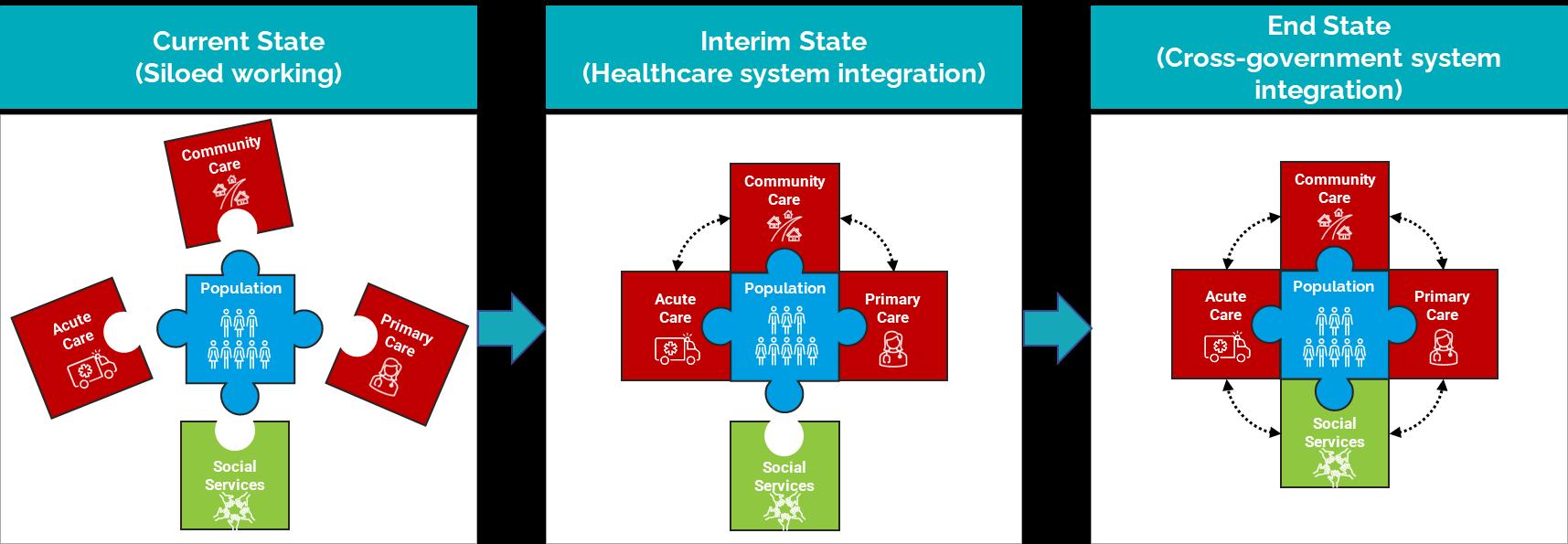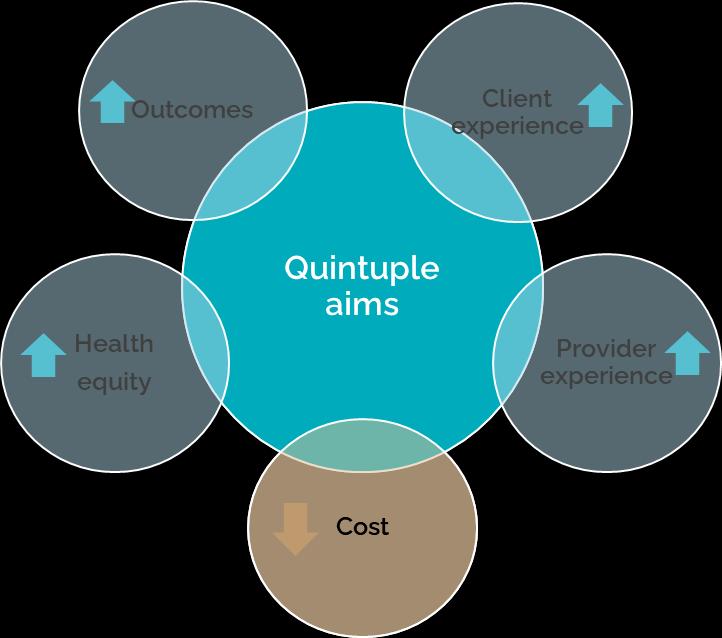Good people, bad system
A vision for integrated regional health and wellbeing systems in Australia

10 November 2022



10 November 2022

Executive summary..................................................................................................................................................................3
Australia’s fragmented health system needs a new approach that joins up care for people ...........................................................................................................................................................................................5
The current healthcare system was designed to treat sickness ...........................................................5
Australia’s ageing population needs a wellness system, not a sickness system......................6
Health systems need to rebalance hospital expenditure towards primary and community care.....................................................................................................................................................................7
Australia’s fragmented health system is buckling under increasing demands 8
We should intelligently apply local and global learnings to build integrated health and wellbeing systems that work in Australia’s diverse regions 10
Australia needs to first define the regional footprints for integrated health and wellbeing systems 10
Regional planning footprints would underpin integrated health and wellbeing systems11
Regional system integration is already happening 18

A national vision of integrated health and wellbeing systems will help regions accelerate these efforts 18
Good people deserve a better system 18


‘Good people, bad system’ aims to provoke ideas and stimulate the national conversation around the design of an integrated, long term national health and wellbeing system.

The title ‘Good people, bad system’ draws inspiration from Deming’s quote ‘A bad system will beat a good person every time.’
When the Australian health system was designed fifty years ago it was a good system. It provided universal healthcare and was very good at treating sick people, which was fine when the average age was 72 years.
Today, the average age has risen to 83. People are living longer and with more complex chronic illness. Because the population has changed, the system is no longer fit for purpose.
Australia now needs a system focused on wellness not sickness.
This document describes a vision for integrated regional health and wellbeing systems that we believe will lay the foundations for the next fifty years. This vision includes the following ten system elements:
Rather than good people trying harder and harder within the current system, now is the time to change the system.



Why does Australia need to reform the health system?


While Australia’s health system compares well against international peers, historical cracks in a fragmented system are fracturing fast. Many regional health systems in Australia are already moving towards integrated regional health and wellbeing systems that focus on improving population health. The government needs to act fast to proactively accelerate this journey.
Australia’s current health system was designed fifty years ago when the average life expectancy was 71 years. Introducing universal healthcare was a brilliant achievement, but the system was designed to treat acute and episodic sickness.

Australia’s fragmented health system needs a new approach that joins up care for peopleGough Whitlam’s 1972 election campaign laid the groundwork for the establishment of Medicare
Today, the healthcare system is even better at treating acute sickness, despite significant inequities between urban and rural/remote communities
Two weeks ago, my wife and I arrived at the Gosford emergency department with our 3 year old son experiencing an asthma attack that was going downhill fast. Within 5 minutes, we were in a resuscitation bay with a dozen fantastic health professionals working towards my son’s eventual recovery. I remain eternally grateful for the quality of care we received. That crisis reminded me how lucky we are to live in a country with a world class health system.


Today, Australian life expectancy has increased to 83 years.
Australia’s life expectancy has increased from 71.6 years in 1972 to 83.4 years in 2019 Advances in healthcare mean that people are living longer, often with multiple chronic diseases. Australia now needs a wellness system that improves both the quantity and quality of life. This is both a moral and financial imperative. Two thirds of Australians over 18 are already overweight or obese. If current trends continue, caring for people with diabetes alone could bankrupt the country.

Australia’s ageing population needs a wellness system, not a sickness system
Creating a wellness system means shifting care upstream and closer to home. We must invest more prevention resources in keeping people well while delivering better and more efficient acute care.
Health system investment needs rebalancing so more care is delivered closer to home


Shifting the balance of investment away from acute hospitals towards primary and community settings is particularly tricky in Australia because the Commonwealth funds primary care. In contrast, the States & Territories fund acute care (2).
Australia’s health system also funds far too much healthcare on the basis of activity. This is problematic because it perversely incentivises every provider to deliver high volume care rather than high value care. In the current system, encouraging hospitals to shift care away from hospital and closer to home is like asking turkeys to vote for Christmas. By incentivising high volumes of fast medicine, activity funding also discourages healthcare professionals from delivering the high quality ‘slow medicine’ needed by people living in rural and remote communities.
The split between State and Commonwealth funding creates a needlessly fragmented system that is frustratingly complex for people to navigate. As people move around the health system, their context does not follow them. Every day people die unnecessarily. But because these deaths happen due to many small health system ‘accidents’ rather than one large system ‘plane crash,’ repeated calls for system reform have not been heard.
Until now.
In addition to the direct health impacts of COVID, the population is increasingly suffering from the indirect effects. Many people have missed early primary care interventions, such as cancer screening, meaning they are sicker when they arrive in the health system
The social dislocation of extended COVID lockdowns has led to a surge in mental health problems. Frazzled health professionals are now being asked to meet increasing demands. Emergency Departments across Australia are buckling under the strain, and more ambulance ramping is leading to worsening patient outcomes.
The metaphorical platform is burning.
Australia’s health system needs urgent reform.





After emigrating to Australia in 2015, I quickly learned how challenging it was for regional system leaders to design integrated services when the States fund most hospital care and the Commonwealth funds most primary care I sensed both resignation and frustration that system leaders faced such an unhelpful technical barrier to commissioning, designing and delivering integrated care.
Recently, I’ve been spending lots of time with hospital CEOs and Primary Health Network CEOs who have been working closely together I am sensing a palpable urgency and impatience to overcome these artificial barriers. Regional health leaders increasingly want to unite and maximise the collective resources available in their regions to improve health outcomes for the populations they serve.
There are many successful case studies where integrated regional health and wellbeing systems have improved care in places like New Zealand, England, Europe and the USA. Many Australian regions have embarked on health system integration programs, but there is no national framework to support these endeavours.
To accelerate the positive changes that are already happening, I believe that Australia must choose a set of geographical footprints to form the basis for regional integrated health and wellbeing systems. The 31 Primary Health Network boundaries already align with their counterpart HHS/LHD/LHN footprints in each State and Territory, so this may be a relatively easy starting point.
Australia’s 31 Primary Health Networks could form the geographical footprint for integrated health and wellbeing systems

We should intelligently apply local and global learnings to build integrated health and wellbeing systems that work across Australia’s diverse
Australia needs to first define the regional footprints for integrated health and wellbeing
The 31 PHN geographies would group populations into similarly sized regions as those used in the 42 Integrated Care Systems across England. English Integrated Care Systems cover populations of around 500,000 to 3 million, which is comparable to the average population footprint of PHNs
PHNs have a very rough population average of 839,000 people (which can be crudely estimated by dividing Australia’s population of roughly 26m people by 31 PHN regions to give a mean average of 839,000 people per region). Obviously, Australia’s vast size, and wildly varying population density gradient between urban and remote regions means regional population numbers vary significantly. But the broad point here is that PHN footprints compare reasonably with other integrated care systems and could provide a starting point for regional geographic footprints (but more work is clearly needed here!)
Once agreed upon, these geographical footprints would become the planning unit for integrated regional health and wellbeing systems. NSW Health has already made this move by using PHN footprints for the Collaborative Commissioning program. PHN footprints define Person Centred Collaborative Commissioning Groups (PCCGs), which are aligned with NSW Local Health District boundaries.
The new government has a fantastic opportunity to outline a vision for integrated regional health and wellbeing systems. We believe that the following ten system elements would enable these systems to succeed:


Rebbeck’s vision for integrated health and wellbeing systems contains ten elements
The ten system elements are described in detail in the rest of this section.
The pace of change of any reform is a future topic for discussion. Clearly, any system reform needs to be implemented carefully with plenty of signposting and time to enable change to be smoothly delivered.



Every integrated health and wellbeing system would focus on achieving the quintuple aims of healthcare by utilising the collective investments being made in the region to improve population outcomes, client experiences, provider experiences and equity
Integrated health and wellbeing systems should strive to achieve the quintuple aims

Every system would be defined by a geographical planning footprint. This footprint could potentially be based on PHN boundaries, as described previously.
Every region would collaboratively commission integrated health and wellbeing services by pooling respective budgets. System leaders would treat the collective resources as a single co commissioned budget, with resources being invested wherever they deliver the greatest impact. This would minimise duplication and avoid leaving service gaps.
To address the social determinants of health, integrated health and wellbeing systems would need to eventually integrate with social services, including education, housing and justice
At present, consumers & health workers are too often consulted about changes to local services late in the decision making process.
In future, local consumers and clinicians would be proactively engaged and empowered to co design services that meet their local community needs
System leaders would unite within an Alliance that forms a ‘guiding coalition for change’ in every region. The Alliancing model has been used effectively in New Zealand and is a simple concept that is underpinned by the same principles used by high performing sports teams.
“The first thing we do when there is a problem, and because this is an alliance, is ask “How can we help? What’s the problem? Can anyone else in the alliance help?” And we put resources in. Because the idea of an alliance is that nobody fails. We either all fail, or all succeed.”
 Carolyn Gullery, Canterbury Healthcare Alliance, New Zealand
Carolyn Gullery, Canterbury Healthcare Alliance, New Zealand

Rebbeck is currently supporting the WNSW Integrated Healthcare Alliance to practically translate international learnings about Alliancing to help the WNSW Alliance succeed. Collaborative system leadership must be underpinned by a shared philosophy and culture based on trust and joint working.
Successful Alliances develop high trust environments where all parties recognise that they will achieve better population outcomes by working together

Health strategies are currently developed in organisational siloes by multiple organisations, each covering different time horizons.
The vision would be for every region to develop a single joint regional health and wellbeing strategy with a supporting implementation plan.
At present, healthcare organisations have a fragmented understanding of population needs based on a fragmented set of needs assessments that are developed by different healthcare organisations and other government departments including education, housing, communities and justice.

The vision would be for each region to develop a single joint strategic needs assessment (JSNA) that enables a shared understanding of regional needs. Critically, this will include a shared understanding of population needs which considers the interplay between primary healthcare, secondary healthcare, aged care, education, housing, justice, and all the agencies responsible for addressing the social determinants of health.
Getting all these agencies to coalesce around a JSNA may sound fanciful, but England's health and social care systems have been developing regional Joint Strategic Needs Assessments for over thirty years, and Rebbeck is currently supporting the Central Coast system to develop its first JSNA.
Combining disparate regional needs assessments into a single regional Joint Strategic Needs Assessment would create significant efficiencies
The vision would see every region being supported by a joint regional health and wellbeing intelligence unit with linked datasets. Instead of multiple organisations working in siloes to analyse population health data, Australian systems should learn from successful integrated health systems in places like the Basque Country in Spain and Canterbury in New Zealand, where regional system analytics underpins decision making.
Regional health and wellbeing commissioners would provide a single source of the truth about population and individual outcomes. Whole system performance would then be visible to all organisations in each region
At the Wild Health summit on 18 October 2022, Dr John Halamka, the President of the Mayo Clinic platform, explained how clinicians working at the Mayo Clinic can review real time health outcomes data for over 14 million people.

Population health analytics is only possible when individual data across different care settings are linked. This is far easier to achieve when analysts are working closer together.

Narrow funding models based predominantly on activity would be replaced by blended funding models that are used to incentivise ‘slow medicine’. This would allow a greater focus on addressing needs and improving outcomes across full cycles of care rather than incentivising high volumes of episodic care.


Travelling around the country, I see countless excellent examples of system leaders collaborating to create integrated regional systems. NSW’s Collaborative Commissioning program is a great example of system leaders uniting to deliver value based care. NSW’s collaborative commissioners are pooling regional funding and creating joint governance between LHDs and their PHN counterparts to co design improved joined up services for the populations they serve
Integrated Care Alliances have sprung up around the country to address system wide issues collectively. For example, the Diabetes Alliance between Hunter New England Local Health District and the PHN has successfully rolled out multi disciplinary team care for more than 3,500 diabetic patients.
The Health Alliance in Brisbane North has set up a Care Collective that has pooled funding and resources from both the State and Commonwealth. The Care Collective is currently wrapping care around a cohort of around 200 frequent presenters to ED to manage their complex chronic illnesses closer to their homes.
Both these examples represent a classic win win for patients and taxpayers.

We believe that the national government needs to urgently communicate a national vision of integrated regional health and wellbeing systems. ‘Early adopter’ system leaders are already moving in this direction, but Australia needs a clear direction so system leaders at every level can work steadily towards a common end state
Australia’s population has changed significantly since the health system was designed fifty years ago.
Australia’s ageing population needs a system focused on wellness, not sickness
Integrated regional health and wellbeing systems will foster a culture of improved regional collaboration, which will harness the collective resources in the system.
People working in regional health systems want their precious time to be focused on delivering lasting health and wellbeing outcomes for their communities.
Now is the time for Australia to overcome artificial barriers and design a better system that enables good people to deliver great outcomes.
national vision of integrated

